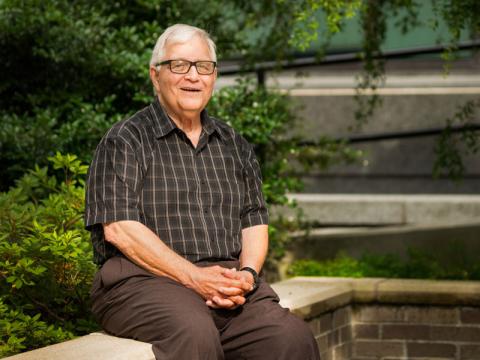Victor J. Law
Professor

Office
323 Lindy Boggs Building
Department of Chemical and Biomolecular Engineering
Tulane University
New Orleans, LA 70118-5674
Courses Taught
Numerical Analysis for Chemical Engineers
Practice School
Process Design and Economics
Automatic Process Control
Advanced Engineering Mathematics
Education & Affiliations
Biography
Through collaboration with researchers at Penn State University, South Carolina University and Argonne National Labs, we are developing processes for several thermochemical cycles that have the potential for efficiencies higher than those obtained through direct electrolysis of water. This work focuses specifically on electrochemical processes and technologies common to cycles of interest (in particular the Copper-Chloride and the Calcium-Bromide cycles). The process modeling and flowsheet construction and analysis expertise provided by Tulane researchers will be used to guide the experimental work performed at the collaborating institutions. This work is supported by a three-year grant from DOE.
Process models often contain unknown parameters that are usually determined by regression methods using experimental data. The traditional technique to determine the parameters involves a nested approach where the parameter estimation algorithm requires a full simulation using the process model when function evaluations are required. A new simultaneous approach has been developed where the parameter estimation objective function (most often a sum of squares of residuals) is minimized and the process model equations (algebraic and/or differential equations) are solved in parallel. When model function evaluations are very time-consuming the simultaneous approach can offer large computational savings.
Another new and powerful method for parameter estimation has been developed by our group. This involves the use of Sliding Mode Observers, a methodology borrowed from control theory. Applications so far have involved parameter estimation for the Monod biokinetics model, which is known to be a difficult parameter estimation problem. Future plans include the use of Sliding Mode Observers for such problems as leak detection in pipelines and problems involving both parameter estimation and estimation of non-measurable system states.
Butanol is a substantially more desirable alternative fuel than ethanol. Its energy content is close to that of gasoline and it is not a desiccant so that water contamination and corrosion issues are not present as with ethanol. A Tulane group consisting of researchers from Chemical & Biomolecular Engineering, Chemistry and the Department of Cell and Molecular Biology are combining expertise to work on butanol production and purification from primarily cellulosic waste materials.
Publications
Recent Journal Papers
Drakunov, S. V. and V. J. Law, “Parameter Estimation for Biochemical Process Kinetics Using Sliding Mode Observers,” submitted to Chemical Product & Process Modeling (May, 2007).
Kesavan, P. and V. J. Law, “Practical identifiability of parameters in Monod kinetics and statistical analysis of residuals,” Biochemical Engineering Journal, 24, 95 - 104 (2005).
Mitchell, B.S. and V. J. Law, “Community-Based Presentations in the Unit Operations Laboratory,” Chem. Eng. Ed., 39[2], 160-163(2005).
P. Kesavan, V. J. Law, and S. K. Bhattacharya, “Computation of Monod Kinetic Parameters without Biomass Data and Initial Substrate Concentration,” Chemical Engineering Communications, 167, 107 - 132 (1998).
Paper Presentations and Research Reports
Law, V. J., J. C. Prindle and R. B. Gonzales, “Analysis of the Copper Sulfate Cycle for the Thermochemical Splitting of Water for Hydrogen Production,” paper submitted for presentation at the 2007 AIChE National Meeting, Salt Lake City, UT (November 2007).
Law, V. J., J. C. Prindle and R. B. Gonzales, “Level 1 and Level 2 Analysis of the Copper Sulfate Cycle for the Thermochemical Splitting of Water for Hydrogen Production,” Contract No. 6F-003762 – Argonne National Laboratory (July, 2006).
Law, V. J., J. C. Prindle and R. B. Gonzales, “Level 3 Analysis of the Copper Sulfate Cycle for the Thermochemical Splitting of Water for Hydrogen Production,” Contract No. 6F-003762 – Argonne National Laboratory (August, 2006).
Law, V. J., J. C. Prindle, R. Bang, K. Hoerger and J. Ledbetter, “Progress Report No. 1 Experimental Studies of the Hydrogen Generation Reaction for the CuSO4 Cycle,” Contract No. 6F-01144 – Argonne National Laboratory (October, 2006).
Law, V. J., J. C. Prindle, R. Bang, K. Hoerger and J. Ledbetter, “Progress Report No. 2 Experimental Studies of the Hydrogen Generation Reaction for the CuSO4 Cycle,” Contract No. 6F-01144 – Argonne National Laboratory (January, 2007).
Law, V. J., J. C. Prindle, R. Bang, K. Hoerger and J. Ledbetter, “Progress Report No. 3 Experimental Studies of the Hydrogen Generation Reaction for the CuSO4 Cycle,” Contract No. 6F-01144 – Argonne National Laboratory (March, 2007).
Law, V. J., J. C. Prindle, R. Bang, K. Hoerger and J. Ledbetter, “Progress Report No. 4 Experimental Studies of the Hydrogen Generation Reaction for the CuSO4 Cycle,” Contract No. 6F-01144 – Argonne National Laboratory (May, 2007).
Law, V. J., J. C. Prindle & A. I. Lupulescu, “Aspen Plus Modeling of the Three-Reaction Version of the Copper-Chloride Thermochemical Cycle for Hydrogen Production from Water,” Contract No. 6F-01144 – Argonne National Laboratory (August, 2007).
